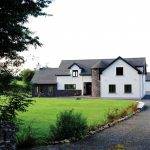Building on a sloping site is difficult enough, which is why losing your main contractor midway through the project probably would send most people running to find a new one. Instead, Robin Wilson saw this as his opportunity to take the reins of the build and finish it off himself.
In this article we cover:
- Deciding to build a bespoke house
- Finding the site and making the most of the views with the slope
- Key design features and why the planners dubbed it the 007 house
- Difficulties going to tender to find a builder, price discrepancies
- Groundwork costs, especially for excavation
- Issues with the builder up to the point of breach of contract
- What he did on a DIY basis
- Saving thousands with the direct labour approach
- Glazing and steel frame construction details
- Systems details: heating, hot water and ventilation
- Professional photographs, supplier list
- Build cost and specification
Overview
Site size: 0.16 acre + 0.15 acre woodland
House size: 450sqm
Build cost: £500,000
Construction type: steel with concrete retaining walls
Insulation: 150mm EPS beads in walls, floor 250mm PIR board, roofs 150mm PIR board
U-values: walls 0.14 W/m2K, floor 0.12 W/m2K, roof 0.14 W/m2K
Windows: double glazed argon filled, 24mm cavity, U-value of units 1.0 W/mK2K
“When my wife Julie and I first got married we built our own home,” says Robin. “The location was ideal at the time, but due to the traffic and the area becoming more built up we decided we needed to move closer to Belfast. We had looked at a variety of homes but realised most of them were built for the general market. While 80 per cent of the population wants this standard layout, it wasn’t for us and that’s when we realised we’d have to build again. This time we thought it would be nice to go really modern.”
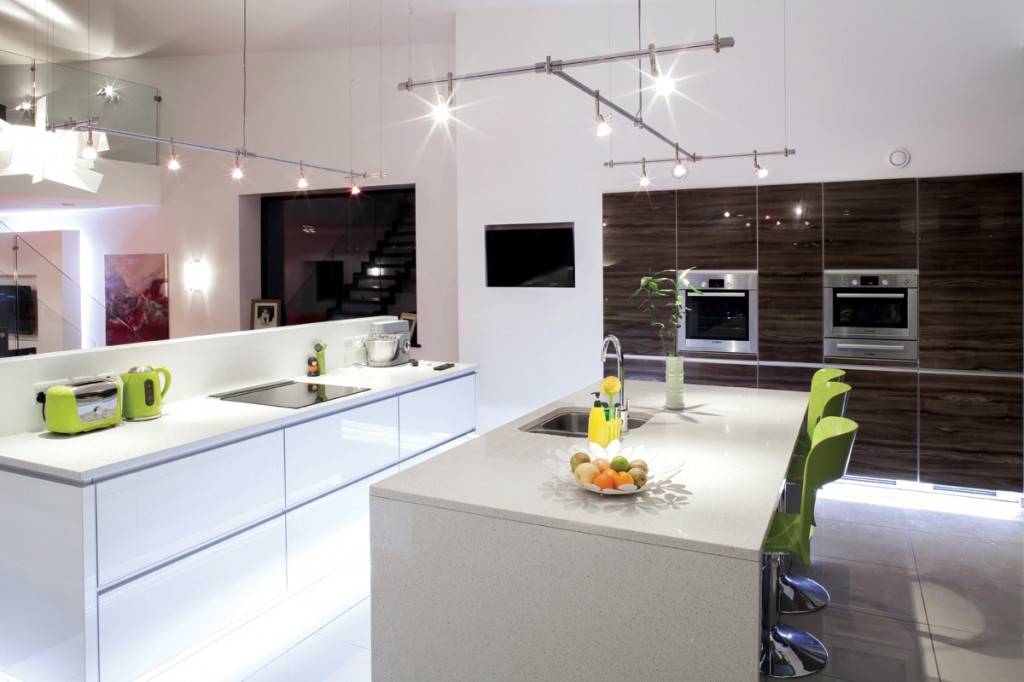
007 house
How the Wilsons got to build their ‘Goldeneye’ house was in large part guided by providence. A few things had to happen; first off they had to get the money to do it, then of course find the right site and, last but not least, commission the right design.
The way they got the funds was typical of the Celtic Tiger years: “We’d bought a flat site on half an acre, near the shore and selected a local architect who charged a reasonable rate, not in the order of 12 to 13 per cent that was commonly asked for at the time. When we met him, we clicked from the start. He knew what we wanted, and at the same time was prepared to push us further. The design was a mix of a little bit conservative and a little bit modern,” says Robin.
“However, just before we were due to start work on the site we were made an offer by a developer that we couldn’t refuse.” This was in 2007.
With money in their pocket they went about looking for another site, with the same architect in tow. When they found the sloping site they were to build on, it was like destiny came knocking at their door. “We knew it would be a challenge but we fell in love with the view and with how private it was. The home came in two packages, one part is in the Belfast metropolitan zone, that’s the sloping site, and the other is a portion of woods behind the house, which is zoned within the greenbelt.”
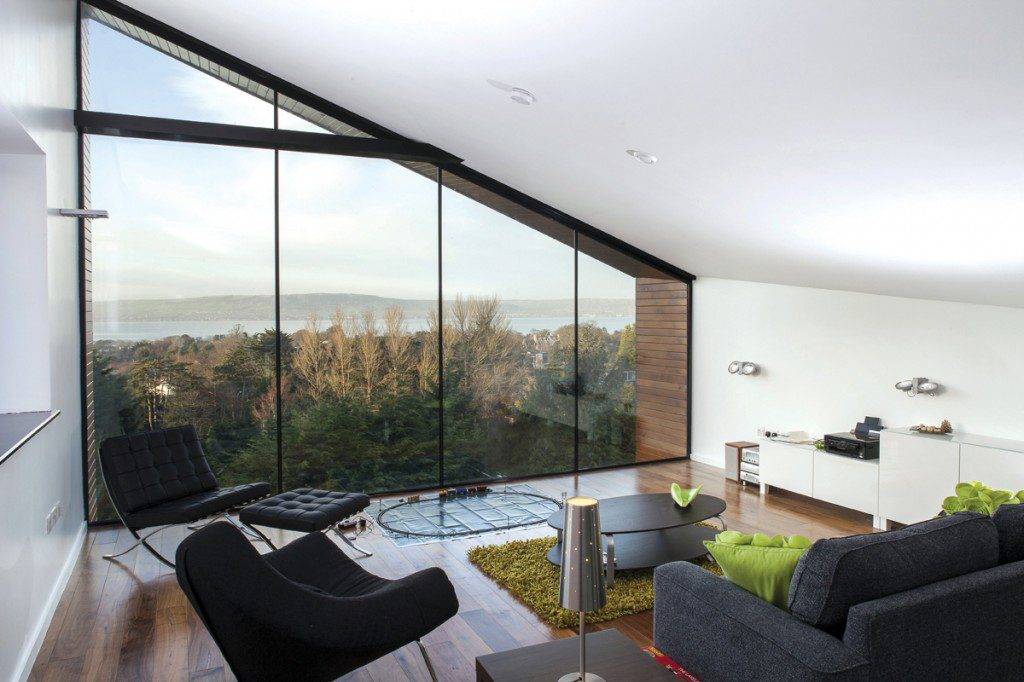
The site was so utterly different to the one they’d just sold that they had to start from scratch. “It’s an incredibly compact site, so we had to bail out on the original plans. We felt guilty about it, we’d poured heart and soul into them, as had the architect.”
Instead of discouraging Robin and Julie’s architect, the change inspired him. “One Thursday afternoon he phones me up and says, ‘Just to warn you I got a 3 o’clock in the morning moment’. He never directly pushes anything but he has a way to prepare you for what’s coming,” says Robin. “When he showed us the upside down design with the loft style living area above the bedrooms, it was fantastic, unbelievable. I couldn’t imagine doing anything better.”
The concept was the cross section of an eye diagram with the line of the roof going down the hill, forming a triangle to represent the face of the home looking out onto the Lough. “It’s ideal as a viewing platform, and from afar all you can see is the wooded structure, which anchors the house into the hill.”
While this home uncannily resembles a James Bond villain’s hideout, the ‘007’ moniker actually came from the planning authority. “They’re the ones that named it 007,” says Robin. “We started the project in 2007 and it was the architectural practice’s 110th job of 07. I can only imagine the planning officer took one look at drawing 11007 and came up with the ‘007 House’.”
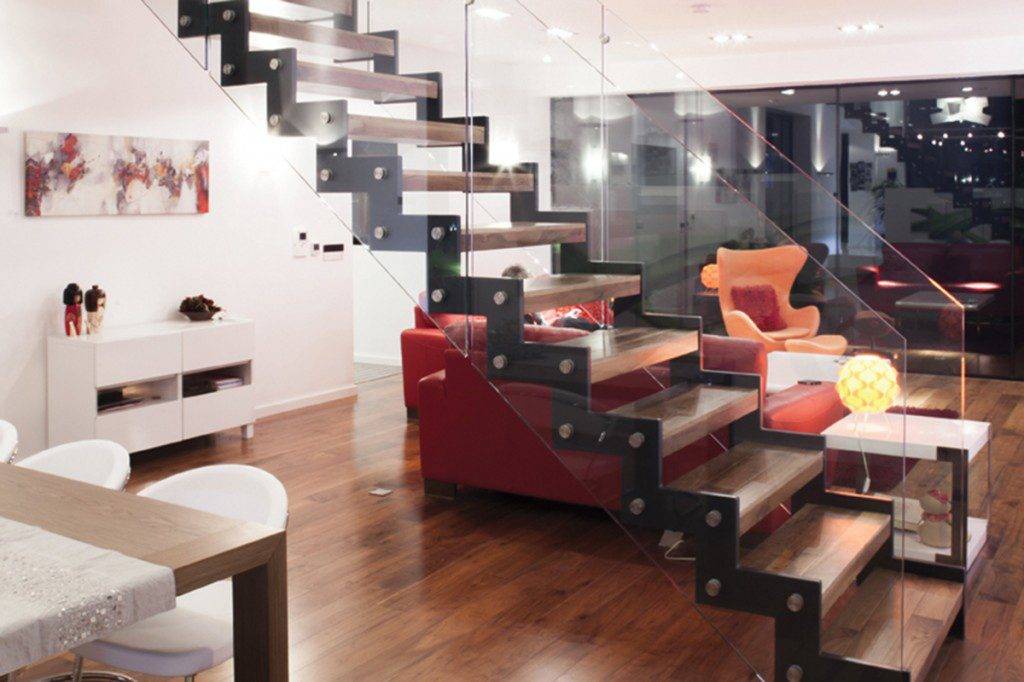
From the ground up
“There were a couple of hurdles with planning, given it’s quite a departure from the norm,” says Robin. “Although there were no objections from the planning department, a neighbour claimed to be overlooked. Based on those comments, minor amendments were requested, so the front face of the original glass balcony had to be taken out. It took a total of nine months to gain permission.”
They then started looking for a builder, and four bids were submitted. “We didn’t get a tender within £150,000 of each other. The problem was how unique this project was. It was simply a case of looking at the site: there was a 3m wide lane as access and a hill to excavate, plus no room to store anything.” The tender process took about three months; a builder was appointed in November 2008 and he started before Christmas.

Originally access to the site was provided via the neighbour’s driveway, and clearly, Robin and Julie wanted their own private entrance. But that meant more excavation, and excavate they certainly did. Four thousand tonnes of soil and rubble were removed and then, after the retaining walls were constructed, 1,500 tonnes put back in. “It was the biggest hole I’ve ever seen!,” says Robin. “The big excavator looked like a toy.”
They were going to put in sheet piling for soil retention while the foundations and retaining walls were constructed, but upon investigation of the soil it was determined it wasn’t necessary. In actual fact excavations went around 2.5m into the bedrock. “We actually broke a rock hammer when we dug down!”
Despite saving on the foundations, other issues cropped up. “We were sitting right on the water table so the site wouldn’t drain. Pools of water would form where the foundations were to be poured,” says Robin. “We had to use a water management system – a large sump drained it from around the foundations.”
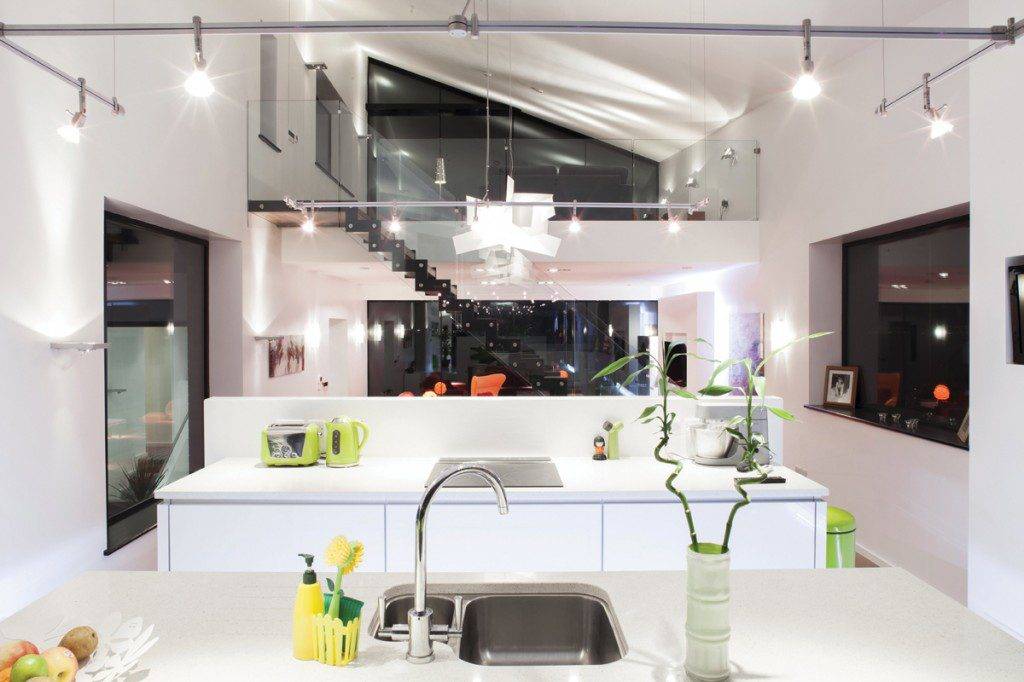
This started to push the budget. “We’d decided to go without much of a contingency,” adds Robin. “And it was gone by the time we’d excavated. Maybe this was the first warning that the builder was disingenuous about his quote.”
For Robin, the most exciting bit at this stage was seeing the retaining walls. “We built a reinforced concrete box in a single pour! Since the waterproof concrete was going to be all underground, they didn’t want any possibility of a leak. So the builder and structural engineer decided it was best to do it in one pour.”
“They started at 7am and didn’t stop until 6pm. The formworks for the retaining wall and buttresses were 28 feet tall, this was more akin to an office block in the Titanic Quarter than building a house.”
“By this stage, with 20 tonne trucks and excavators going up and down a dirt track we’d wrecked the land,” says Robin. “It went on for three months… we ended up getting very good at appeasing our neighbours.”
Another foundation pour was added at third floor level, along with a corresponding retaining wall. “The concrete was poured up to April 2009, and in the meantime the builders were putting up blockwork,” says Robin.
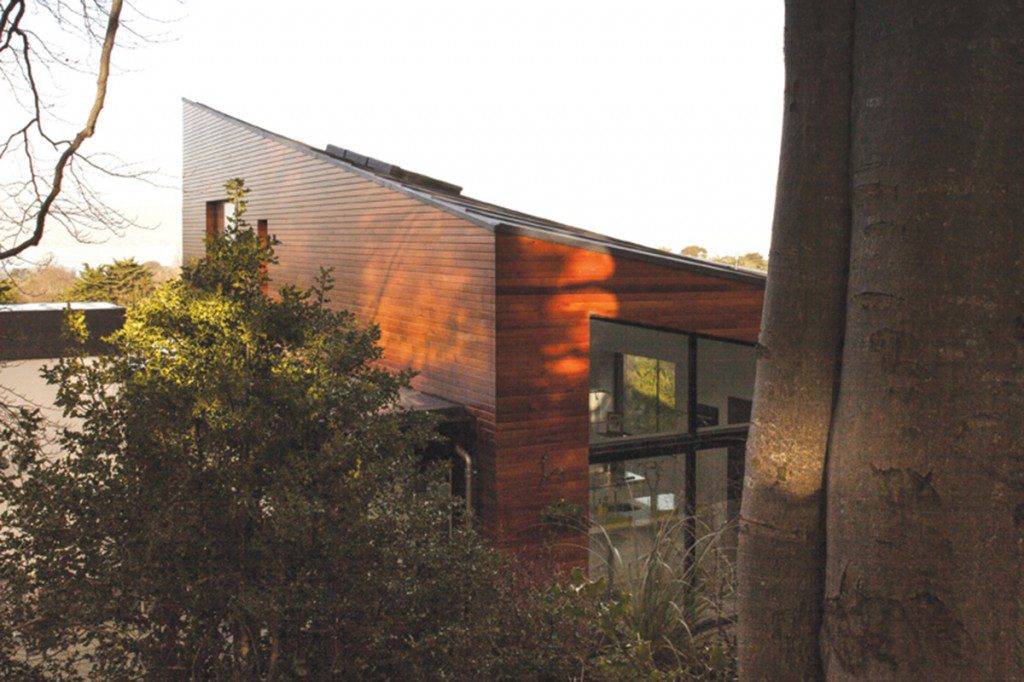
“In June/July the structural steel came in for the top section of the building, along with the corresponding hollowcore slabs for the floors. At that point we could see what the house would look like and what the view from the house would really be like. You could see so much more from this forward vantage point as compared to being at the same height further back on the hill.”
The windows we slotted directly into the steel frames. “Without individual frames it gave us a better U-value and it was approximately the same price, so it was a no brainer. The front glass is structural because of the wind loading, and it consists of large 3m x 1.5m double glazed units jointed together with silicone.” Needless to say they had to be brought in by crane.
Hot water and heating is provided via an air source heat pump, plus a heat recovery ventilation unit. There’s underfloor heating throughout and the house was designed to be airtight. “This home is nearly twice the size of our previous house yet the energy bill is the same.”
It pays to pay attention
“In July 2009 things were still ok with the builder,” says Robin. “It was going a little slower than it should but it was still fine. In October/November, we had most of the windows in and the roof was mostly up. We chose a standing seam system, as this helps channel the water to the side gutter. We’d have a deluge at one end without it! We also chose it for its looks and it’s got a 30 year guarantee.”
In the run up to Christmas, work started to slow down on site. “Most of the shell was complete but the house still wasn’t weather tight. Despite this, in January 2010 the builder started plaster boarding and generally doing things out of order.”
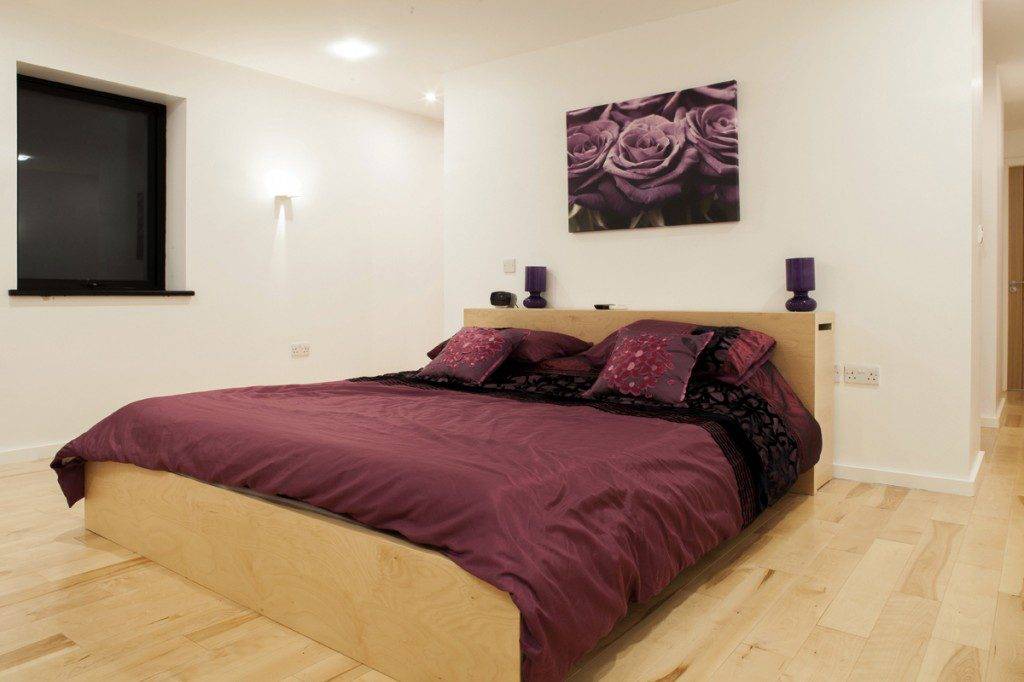
“When he was appointed in late November 2008, it was meant to be a 14 month contract. We’d extended this to the end of March 2010 when it was clear it would not be completed on time, but even that deadline now looked improbable.”
“There was no formal quantity surveyor on the project but the building company had provided a detailed breakdown of all of the labour and material costs for each aspect of the build. So at the various stages I’d check what had been done against the schedule,” adds Robin. “This was how we would verify the builder’s monthly claims for payment.”
“I have to admit I’m probably not the easiest client to deal with! I was heading over there every night to see progress. So I knew more about the site than they did and they didn’t like that. But it meant we didn’t get ripped off. It pays to pay attention.”
“So when we got to January 2010 the builder started to claim for stuff he hadn’t done. For example, he said he’d completed the cedar cladding, and it was clear from looking at the building this wasn’t the case. When we questioned it in his claim, he simply walked off the job. The build had ground to a halt anyway, going slower and slower. He had other work in England and in the South of France.”
At that stage the builder said Robin was in breach of contract. “We called their bluff. At the start we tried resolving the dispute amicably but then when this was getting nowhere we realised we had to invoke the terms of the contract we had signed with the builder and ended up having to spend money on legal fees. The architect also really helped us out, sorting out the various elements. Strong friendships arise of out of that, and respect.”
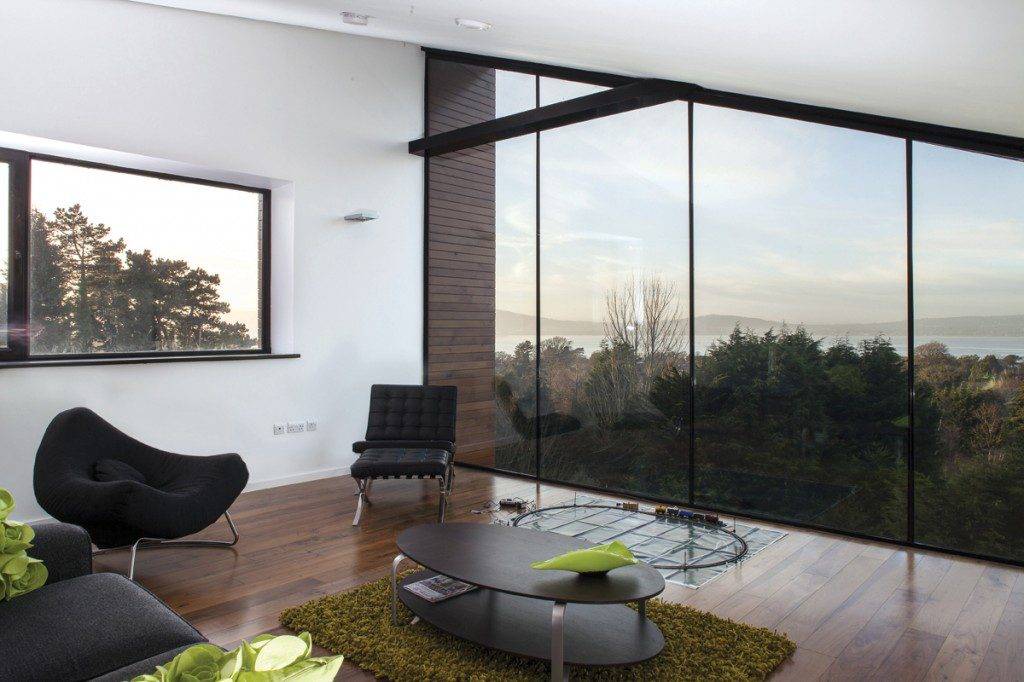
In May 2010 Robin and Julie legally took back control of the site.” It took us three to four months to fire them forcefully under the contract,” adds Robin.
“As the shell and civil engineering works had been completed, I decided to finish the rest myself,” says Robin. “There still was the joinery, roof, electrical work and so on, left to do, but I thought that it was something somebody relatively technically minded could get their head around. The good thing was I was able to get the original subbies, those who did the first fix. I knew the electrician, the joiners, the plumber and the ground work contractors. I felt it was better that no one had to take on someone else’s work.”
Towards the end the builder had started getting sloppy and Robin’s first job was to rectify his mistakes. “The levels in the home were wrong so we had to get them changed. We had to redo the underfloor heating, and put in thinner insulation than what was there. The intention was to use 75mm EPS beneath the pipework and screed, but because the builder was off by around 50mm, we had to change the insulation to PIR (for the same insulation value, it’s thinner but more expensive than EPS) and then use a slightly thinner screeding layer.
As for the cedar, it was meant to be coated and it hadn’t been. The idea was always to maintain the original tan reddish colour of the wood. It had started to grey, so we went around and sanded it all down.”
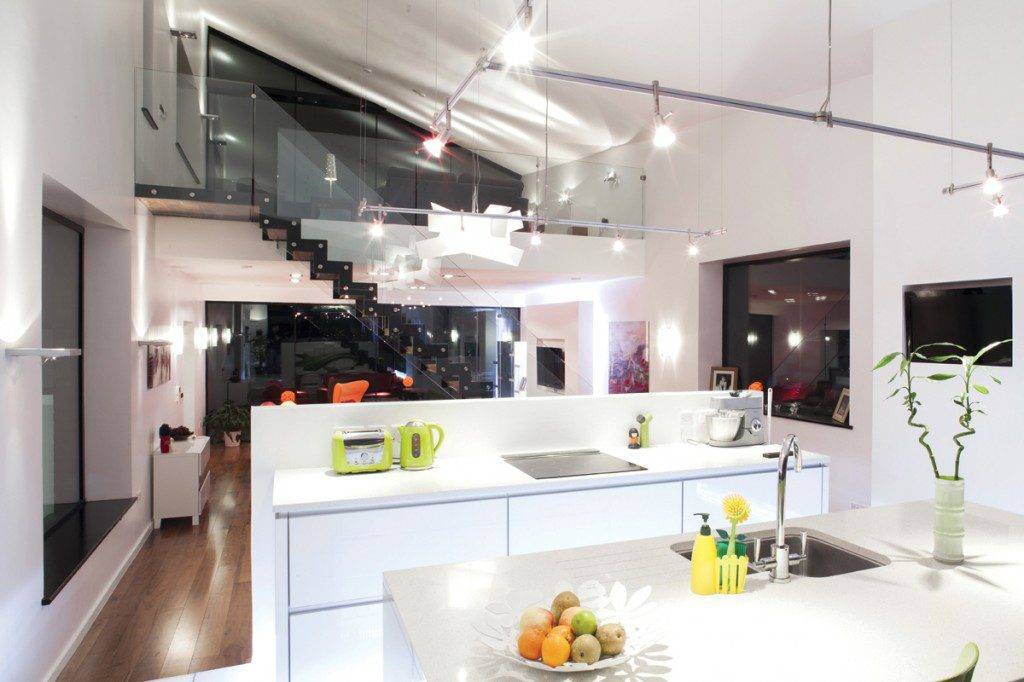
An adventure we’ll never forget
“We’d thought the new house would be completed around March 2010, so we put the house we were living in on the market at that time. It sold within the month, with a completion date of August 2010, which meant that would be the date we would move into our new house. Come August, there was no water, electricity or sanitation,” says Robin. “We had a portaloo and generator in the garage.”
For three months they lived alongside the builders. “At the end of October we put in the electricity and the heating, otherwise it would have been unbearable to spend the winter.”
Robin did all of the internal finishes, tiling, painting, as well as the garden work. “Because in the previous home I had done quite a bit of work, I was familiar with what to do. I had found tilling therapeutic and looked forward to taking this on, but by the time I’d done four and a half bathrooms I didn’t want to see a tile ever again.”
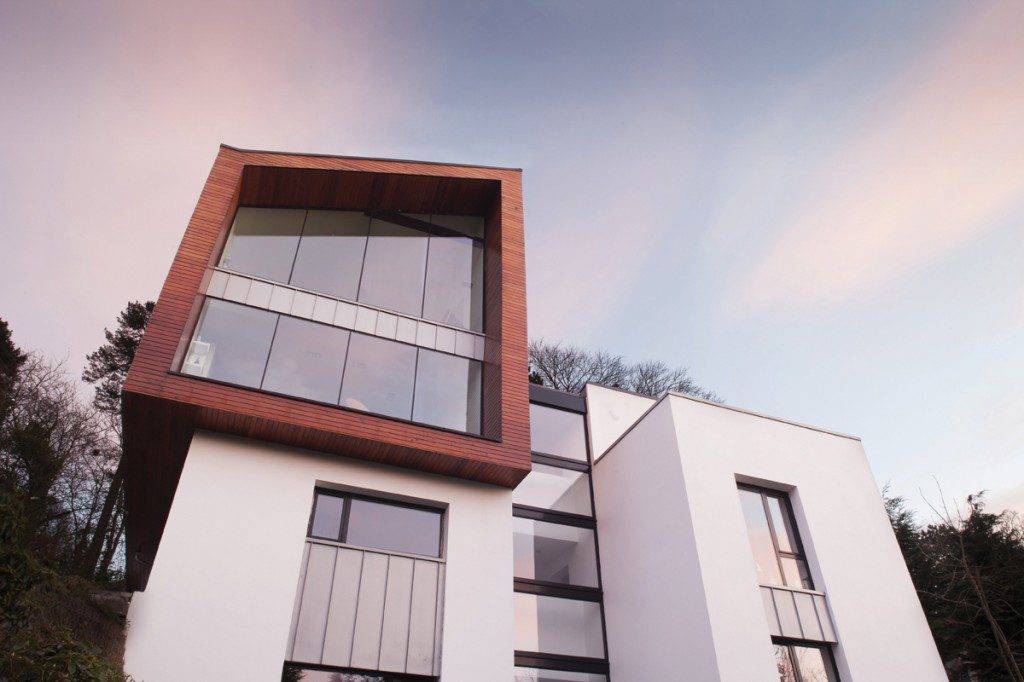
Their suppliers, he says, have been immensely gracious. “They have had a huge amount of patience, for example, the bathrooms were ordered in February 2009 as we thought we’d fit them by the following March, instead the company agreed to hold on to them for what turned out to be one and a half years.”
The kitchen is referred to as minimalist German design. “We’ve kept the living, dining and kitchen all open plan and everything’s hidden away. All you can see of the kitchen really are the stone counters, but if you look carefully you can see the individual hob/sink/oven,” says Robin. “It keeps the contemporary concept going, no clutter.”
“We were always worried about a messy kitchen being in full view – teenagers aren’t renowned for their tidiness, and I’m not the best either. But with the storage solutions and dishwasher provided under the counters, it’s not difficult to quickly and easily maintain the show house image. And the more you get used to it being clean, the more inclined you are to keep it like that.”
“As a self-confessed watcher of TV show Grand Designs, I must say some of Kevin McCloud’s comments ring true. A well designed building does enhance the lives of those who live in it. Given the location and design, I wake up and feel better. I never have to look for the view, it’s just there. Even where you don’t expect it.”
But considering this is their home for life, four and a half storeys to climb at retirement age doesn’t seem so appealing. “We incorporated a lift shaft with the services ready for installation but since we may only need it in 20 years’ time we didn’t put one in. For now the space is used as storage room.”
“To be fair I think the process probably worked out to our advantage financially. Most of the extras in homes usually come in at the end. But if you are paying for the necessary trades on a day rate, you can control the cost of these proposed extras by avoiding inflated per item prices that a builder will often quote if he is in control of the build right to the end. For the finishes and extras we included in that completion phase, the self-build approach saved us thousands of pounds.”
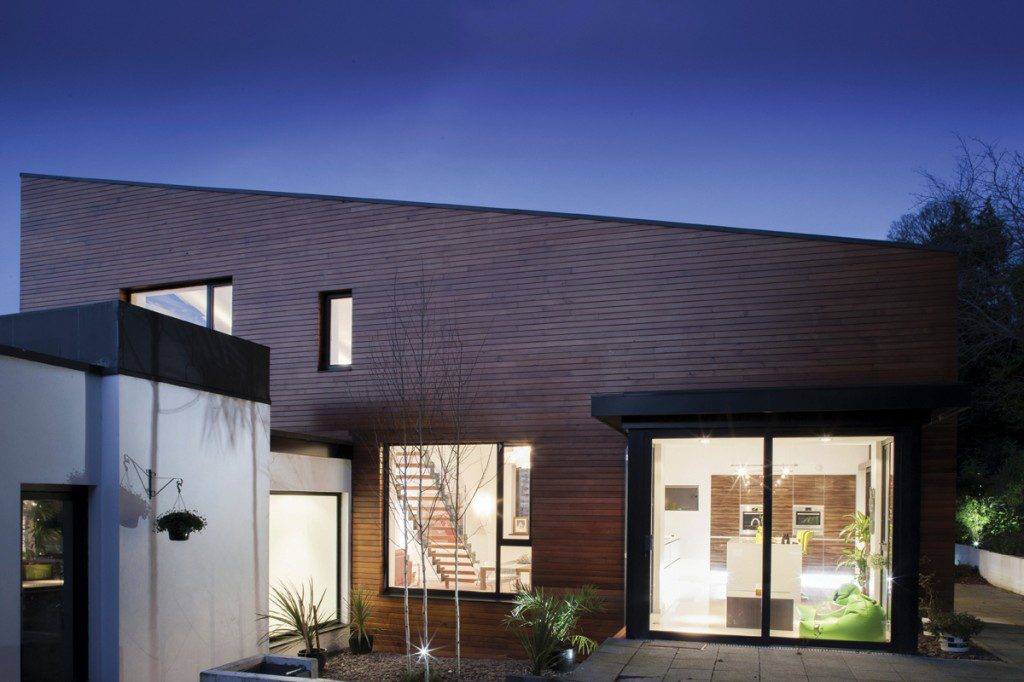
But you do have to squirrel away some money for the inevitable extras, he says. “You need a contingency, whether you plan for it in the contract or have a sum of money you keep to yourself and not let the builder (or architect) know about. It’s going to run over.”
It took a total of six months to finish the whole thing off, and mid 2011 the home was finally completed. “It was really worth it, we got exactly what we wanted. I can’t honestly think we’ll find something better than this,” says Robin. “In the end it was more like an odyssey than a journey. This is an adventure we’ll never forget. Organising the trades really wasn’t a big problem. The home became a part of me, it defined me. I loved the experience. I only wish I had enough money to do it all again, but if I did decide to build another house, I think my wife would leave me.”
Buils spec
Construction type: steel with concrete retaining walls
Insulation: 150mm EPS beads in walls, floor 250mm PIR board, roofs 150mm PIR board
U-values: 0.14 W/m2K for the walls, 0.12 W/m2K for floor & 0.14 W/m2K for roof?
Windows: Argon filled, double glazed, 24mm cavity, U-value of units 1.0 W/m2
Suppliers
Architect
BGA Architects, Newtownards, Co Down, tel. 9181 5736, www.bga-ni.com
Roof
Renolit Alkorplan, www.alkorproof.com
Insulation
Springvale for the walls, www.springvale.co.uk, Kingspan Insulation for the roof and floor www.kingspaninsulation.com
Heating
Mitsubishi Ecodan Heat pump – 14kW
Heat recovery
2x Vortice Prometeo HR 400
Electrical work
RBS Electrics, 207 Abbey Rd, Millisle
Joinery
Savage Brothers Joinery, Portaferry, mobile 07738 510238
Underfloor Heating
Ecovision Systems Ltd, Barley Court, Doughton, Tetbury, Gloucestershire GL8 8TQ
Flooring
Ambience 2, Balmoral Link, Boucher Road, Belfast, Antrim BT12 6QB
tel. 028 9066 7911
Lighting
Lighting Design 14 Boucher Way Belfast, County Antrim BT12 6RE
tel. 028 9066 6878
Windows
Baskil Window Systems, 62 Glenavy Road, Crumlin, BT 29 4LE
Doors
Meadowvale Architectural Joinery 51 Aughintober Road, Dungannon BT70 3DA
Glass Staircase and metal trim
McCormick Metal Fabrications 213 Derryboy Road, Downpatrick, BT30 9DL
Bathroom
Soaks Bathrooms 5-7 Apollo Road, Belfast, BT12 6HP
Zinc Cladding
Edgeform Fabrications Ltd, 106a Pond Park Road, Lisburn








